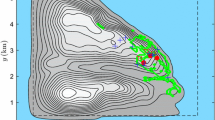Abstract
A numerical model was developed to simulate neutrally stratified air flow over and through a forest edge. The spatially averaged equations for turbulent flow in vegetation canopies are derived as the governing equations. A first-order closure scheme with the capability of accounting for the bulk momentum transport process in vegetation canopies is employed. The averaged equations are solved numerically by a fractional time-step method and successive relaxation. The asymptotic solution in time is regarded as the steady-state solution. Comparisons of model output to the field measurements of Raynor (1971) indicate that the model provides a realistic mean flow.
Momentum balance computations show that the pressure gradient induced by the wind blowing against the forest edge is significant and has the same order of magnitude as the drag force in the edge region. The edge effect involves the generation of drag forces, the appearance of a large pressure gradient, the upward deflection of mean flow and the transport of momentum into the edge of the canopy.
Similar content being viewed by others
Bibliography
Albini, F. A.: 1981, ‘A Phenomenological Model for Wind Speed and Shear Stress Profiles in Vegetation. Cover Layers’, J. Appl. Meteorol. 20, 1325–1335.
Albini, F. A.: 1983, ‘Wind Flow into a Model Forest Reexamined’, Proc. 7th Conf. on Forest Meteorology, Am. Meteorol. Soc., pp. 15–122.
Bache, D. H.: 1986, ‘Momentum Transfer to Plant Canopies: Influence of Structure and Variable Drag’, Atmos. Environ. 20, 1369–1378.
Bear, J., and Bahmat, Y.: 1984, ‘Transport Phenomena in Porous Media-Basic Equations’, in J. Bear and M. Y. Corapcioglu (eds.), Fundamentals of Transport Phenomena in Porous Media, Martinus Nijhoff, New York, pp. 3–61.
Bergen, J. D.: 1975, ‘Air Movement in a Forest Clearing as Indicated by Smoke Drift’, Agric. Meteorol. 17, 111–133.
Blackadar, A. K.: 1962, ‘The Vertical Distribution of Wind and Turbulent Exchange in a Neutral Atmosphere’, J. Geophys. Res. 67, 3095–3102.
Chorin, A. J.: 1968, ‘Numerical Solution of the Navier-Stokes Equations’, Math. Comp. 23, 341–354.
Cionco, R. M.: 1965, ‘A Mathematical Model for Air Flow in a Vegetative Cover’, J. Appl. Meteorol. 4, 517–522.
Cowan, I. R.: 1968, ‘Mass, Heat and Momentum Exchange Between Stands of Plants and Their Atmospheric Environment’, Q. J. R. Meteorol. Soc. 94, 523–544.
Finnigan, J. J.: 1979, ‘Turbulence in Waving Wheat I. Mean Statistics and Honami’, Boundary-Layer Meteorol. 16, 181–211.
Finnigan, J. J.: 1985, ‘Turbulent Transport in Flexible Plant Canopies’, in B. A. Hutchison and B. B. Hicks (eds.), The Forest-Atmosphere Interaction, D. Reidel Publishing Company, Dordrecht/Boston/Lancaster, pp. 443–480.
Fritschen, L. J., Driver, C. A., Burfo, J., Edmunds, R., Kinerson, R., and Schuess, P.: 1970, ‘Dispersion of Air Tracers into and Within a Forested Area’, Tech. Rep. ECOM-68-G8–3, U.S. Army Electronics Command, Ft. Huachuca, AZ, 52 pp.
Gray, W. G.: 1975, ‘A Derivation of the Equations for Multi-Phase Transport’, Chem. Eng. Soc. 30, 229–233.
Hallidin, S.: 1985, ‘Leaf and Bark Area Distribution in a Pine Forest’, in B. A. Hutchison and B. B. Hicks (eds.), The Forest-Atmosphere Interaction, D. Reidel Publishing Company, Dordrecht/Boston/Lancaster, pp. 39–58.
Kawatani, T. and Meroney, R. N.: 1971, ‘Turbulence and Wind Speed Characteristics within a Model Canopy Flow Field’, Agric. Meteorol. 7, 143–158.
Kawatani, T., and Sadeh, W. Z.: 1971, ‘An Investigation of Flow over High Roughness’, Res. and Dev. Tech. Rep. ECOM-C-0423–10, U.S. Army Electronics Command, Ft. Monmouth, NJ. 161 pp. (CER 71–72TK-WZS3; Colorado State University, Fort Collins, CO.)
Li, Z. J., Miller, D. R., and Lin, J. D.: 1985, ‘A First-Order Closure Scheme to Describe Counter-Gradient Momentum Transport in Plant Canopies’, Boundary-Layer Meteorol. 33, 77–83.
Lin, J. D. and Miller, D. R.: 1985, ‘A Preliminary Field Study of Turbulent Flow over and inside a Forest Edge’, Tech. Dept. U.S. ARO. Renewable Natural Resources Dept. University of Connecticut, pp. 120.
Massman, W.: 1987, ‘A Comparative Study of Some Simple Mathematical Models of the Mean Wind Structure and the Aerodynamic Drag of Plant Canopies’, Boundary-Layer Meteorol. 40, 179–197.
Meyers, T. and Paw, U. K. T.: 1986, ‘Testing of a Higher-Order Closure Model for Modeling Airflow within and above Plant Canopies’, Boundary-Layer Meteorol. 37, 297–311.
Meroney, R. N.: 1968, ‘Characteristics of Wind and Turbulence in and above Model Forests’, J. Appl. Meteorol. 7, 780–788.
Miller, D. R.: 1980, ‘The Two-Dimensional Energy Budget of a Forest Edge with Field Measurements at a Forest-Parking Lot Interface’, Agric. Meteorol. 22, 53–78.
Raupach, M. R. and Thom, A. S.: 1981, ‘Turbulence in and above Plant Canopies’, Ann. Rev. Fluid Mech. 13, 97–129.
Raupach, M. R. and Shaw, R. H.: 1982, ‘Averaging Procedures for Flow within Vegetation Canopies’, Boundary-Layer Meteorol. 22, 79–90.
Raynor, G. S.: 1971, ‘Wind and Temperature Structure in a Coniferous Forest and a Contiguous Field’, For. Sci. 17, 351–363.
Sadeh, W. Z.: 1975, ‘Simulation of Flow above Forest Canopies’, in D. A. DeVries and N. H. Afgan (eds.), Heat and Mass Transfer in the Biosphere, Part I, J. Wiley & Sons, N.Y., pp. 251–263.
Shaw, R. H.: 1977, ‘Secondary Wind Speed Maxima inside Plant Canopies’, J. Appl. Meteorol. 16, 514–521.
Shinn, J. H.: 1971, ‘Steady State Two-dimensional Air Flow in Forests and the Disturbance of Surface Layer Flow by a Forest Wall’, Ph.D. Thesis, University of Wisconsin, Madison, 91 pp.
Thom, A. S.: 1972, ‘Momentum, Mass and Heat Exchange of Vegetation’, Q. J. R. Meteorol. Soc. 98, 124–134.
Whitaker, S.: 1968, Introduction to Fluid Mechanics, Prentice-Hall, Englewood Cliffs.
Whitaker, S.: 1969, ‘Advances in Theory of Fluid Motion in Porous Media’, Ind. Eng. Chem. 61, 14–28.
Whitaker, S.: 1973, ‘The Transport Equations for Multi-Phase Systems’, Chem. Eng. Sci. 28, 139–147.
Wilson, J. D.: 1988, ‘A Second-Order Closure Model for Flow through Vegetation’, Boundary-Layer Meteorol. 42, 371–391.
Wilson, N. R. and Shaw, R. H.: 1977, ‘A Higher-Order Closure Model for Canopy Flow’, J. Appl. Meteorol. 16, 1198–1205.
Author information
Authors and Affiliations
Rights and permissions
About this article
Cite this article
Li, Z., Lin, J.D. & Miller, D.R. Air flow over and through a forest edge: A steady-state numerical simulation. Boundary-Layer Meteorol 51, 179–197 (1990). https://doi.org/10.1007/BF00120467
Accepted:
Issue Date:
DOI: https://doi.org/10.1007/BF00120467




